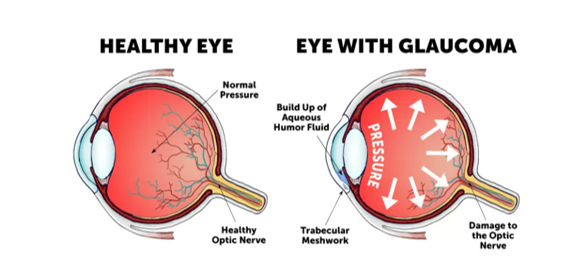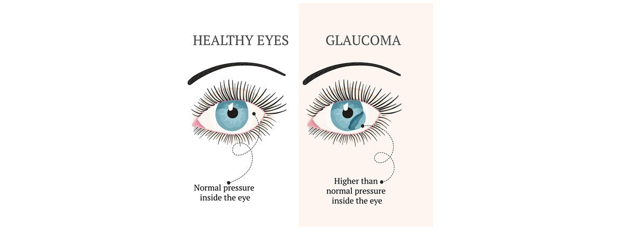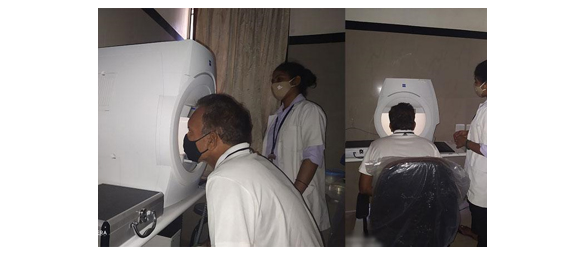
21
Feb
What Is Glaucoma?
World Glaucoma Day is observed on March 12. Glaucoma is a condition in which the optic nerve of the eye is damaged. It evolves with time and only gets worse. An increase in intraocular pressure is commonly linked to it. It is a hereditary condition that runs in families and is often not detected until later in life.
The optic nerve, which transmits visual information to the brain, can be damaged by intraocular pressure, or pressure inside the eye. One of the most prevalent side effects of Glaucoma is vision loss, which can progress to total blindness in a matter of years if the damage worsens.

The majority of persons with Glaucoma do not experience any early signs of discomfort. It is impossible to restore vision once it has been lost. On the other hand, lowering the eye pressure can help maintain your vision. Most patients with Glaucoma can maintain their eyesight if they stick to their treatment program and get frequent eye checkups.
Types of Glaucoma
Here are the two types of Glaucoma that occur in the eyes these include:
Even though it is uncommon, many individuals have optic nerves responsive to normal eye pressure. This means they have a higher than average chance of developing Glaucoma. Regular eye examinations are necessary to detect early symptoms of optic nerve impairment.
Angle-closure Glaucoma affects many patients throughout time, and this is medically referred to as Chronic angle-closure Glaucoma. They don't realise they have this until the situation worsens and they have an attack because there are no indicators at first. If not treated promptly, angle-closure Glaucoma can result in blindness.
How to spot Glaucoma risk factors?

Chronic types of Glaucoma can trigger vision loss even before symptoms or indicators appear so, watch out for the following risks of Glaucoma:
An early diagnosis can save your eyesight

Glaucoma may affect anybody, although some people are more susceptible than others. Many patients with Glaucoma in its early stages have no symptoms, and they could have already observed alterations to their lateral or peripheral vision by the time they were diagnosed.
People aged 40 and above and those over 60, particularly Hispanics/Latinos and those with a family background of the illnesses, are at risk. Glaucoma is a condition that develops gradually over time, and there are no signs or symptoms and no visible vision loss.
Glaucoma can be treated with medications or surgery if diagnosed early as hence, the eyes can be protected from significant vision loss. Without your knowledge, over 40% of your vision might be gone.
As the condition advances, blind patches in the peripheral or side vision appear. By the time you see these spots, the optic nerve may already be severely injured, and the worst thing is that the damage is irreversible.
As a result, early diagnosis and treatment are the only ways to keep the condition under control and prevent visual loss. The most frequent Glaucoma therapy is prescription eye drops to reduce eye pressure and improve vision. Persistent optic nerve damage can be minimised and additional vision loss avoided by regulating eye pressure. Essentially, early detection and intervention can save eye vision.
How to prevent Glaucoma?
If you face a high risk of Glaucoma, your eyes should be tested more regularly. Inquire with your doctor about the best screening schedule for you. These self-care tips can help anyone diagnose Glaucoma in its beginning phases, which is critical for avoiding or reducing vision loss.
Conclusion
If an individual is at a higher risk, they should get a complete dilated eye check every two years, and they should also encourage other family members to do the same. Instead, go to any eye clinic to get eyes tested regularly.
If anyone is diagnosed with this condition, go to a specialised eye care centre to begin treatment as soon as possible. Please book an appointment with Remedy multi-speciality hospital to learn more about your eye health from their specialised doctors.
Types of Glaucoma
Here are the two types of Glaucoma that occur in the eyes these include:
- Primary open-angle Glaucoma
Even though it is uncommon, many individuals have optic nerves responsive to normal eye pressure. This means they have a higher than average chance of developing Glaucoma. Regular eye examinations are necessary to detect early symptoms of optic nerve impairment.
- Angle-closure Glaucoma
- Suddenly the eyesight becomes hazy.
- There is a lot of agony in the eyes.
- A severe headache is experienced.
- There is a feeling of sickness and vomit.
- In the vision, multicoloured rings and halos appear around the lights.
Angle-closure Glaucoma affects many patients throughout time, and this is medically referred to as Chronic angle-closure Glaucoma. They don't realise they have this until the situation worsens and they have an attack because there are no indicators at first. If not treated promptly, angle-closure Glaucoma can result in blindness.
How to spot Glaucoma risk factors?

Chronic types of Glaucoma can trigger vision loss even before symptoms or indicators appear so, watch out for the following risks of Glaucoma:
- Having high internal eye pressure (increased intraocular pressure).
- Being above 60 years old.
- Having had some eye surgery or have experienced an eye injury.
- Obesity, cardiovascular disease, hypertension, and sickle cell anaemia are medical problems.
- The condition is more prevalent in African, Asian, or Hispanic populations.
- Having family members that have Glaucoma.
- Having corneas with a thin central layer.
- Long-term use of corticosteroid drugs, particularly eye drops.
- Extreme nearsightedness or farsightedness.
An early diagnosis can save your eyesight

Glaucoma may affect anybody, although some people are more susceptible than others. Many patients with Glaucoma in its early stages have no symptoms, and they could have already observed alterations to their lateral or peripheral vision by the time they were diagnosed.
People aged 40 and above and those over 60, particularly Hispanics/Latinos and those with a family background of the illnesses, are at risk. Glaucoma is a condition that develops gradually over time, and there are no signs or symptoms and no visible vision loss.
Glaucoma can be treated with medications or surgery if diagnosed early as hence, the eyes can be protected from significant vision loss. Without your knowledge, over 40% of your vision might be gone.
As the condition advances, blind patches in the peripheral or side vision appear. By the time you see these spots, the optic nerve may already be severely injured, and the worst thing is that the damage is irreversible.
As a result, early diagnosis and treatment are the only ways to keep the condition under control and prevent visual loss. The most frequent Glaucoma therapy is prescription eye drops to reduce eye pressure and improve vision. Persistent optic nerve damage can be minimised and additional vision loss avoided by regulating eye pressure. Essentially, early detection and intervention can save eye vision.
How to prevent Glaucoma?
If you face a high risk of Glaucoma, your eyes should be tested more regularly. Inquire with your doctor about the best screening schedule for you. These self-care tips can help anyone diagnose Glaucoma in its beginning phases, which is critical for avoiding or reducing vision loss.
- Schedule dilated eye examination regularly. Glaucoma can be detected early in a complete eye checkup before it causes significant damage. If you're under 40 years old, the American Academy of Ophthalmology advises a thorough eye exam every five to ten years.
- For 40-45-year-olds, every two to four years.
- For 55 to 64-year-olds, every one to three years.
- For over 65 years or above, every one to two years.
- It is essential to be aware of the family medical history, especially eye problems history. Glaucoma is almost always an inherited disease. Individuals who are aware of this should get screened more regularly.
- Exercise in a safe manner. Regular, gentle exercise can help against developing Glaucoma by lowering ocular pressure. Consult a doctor regarding an exercise regimen that is right for you.
- Take the eye drops as directed daily. Glaucoma eye drops will dramatically lower the risk of Glaucoma developing from excessive eye pressure. Although you don't have any symptoms, eye drops recommended by your doctor must be taken daily to be successful.
- Protect your eyes by wearing sunglasses since Glaucoma is also a result of significant eye damage. Wear safety glasses when operating power tools or enjoying various sports in indoor courts.
Conclusion
If an individual is at a higher risk, they should get a complete dilated eye check every two years, and they should also encourage other family members to do the same. Instead, go to any eye clinic to get eyes tested regularly.
If anyone is diagnosed with this condition, go to a specialised eye care centre to begin treatment as soon as possible. Please book an appointment with Remedy multi-speciality hospital to learn more about your eye health from their specialised doctors.






